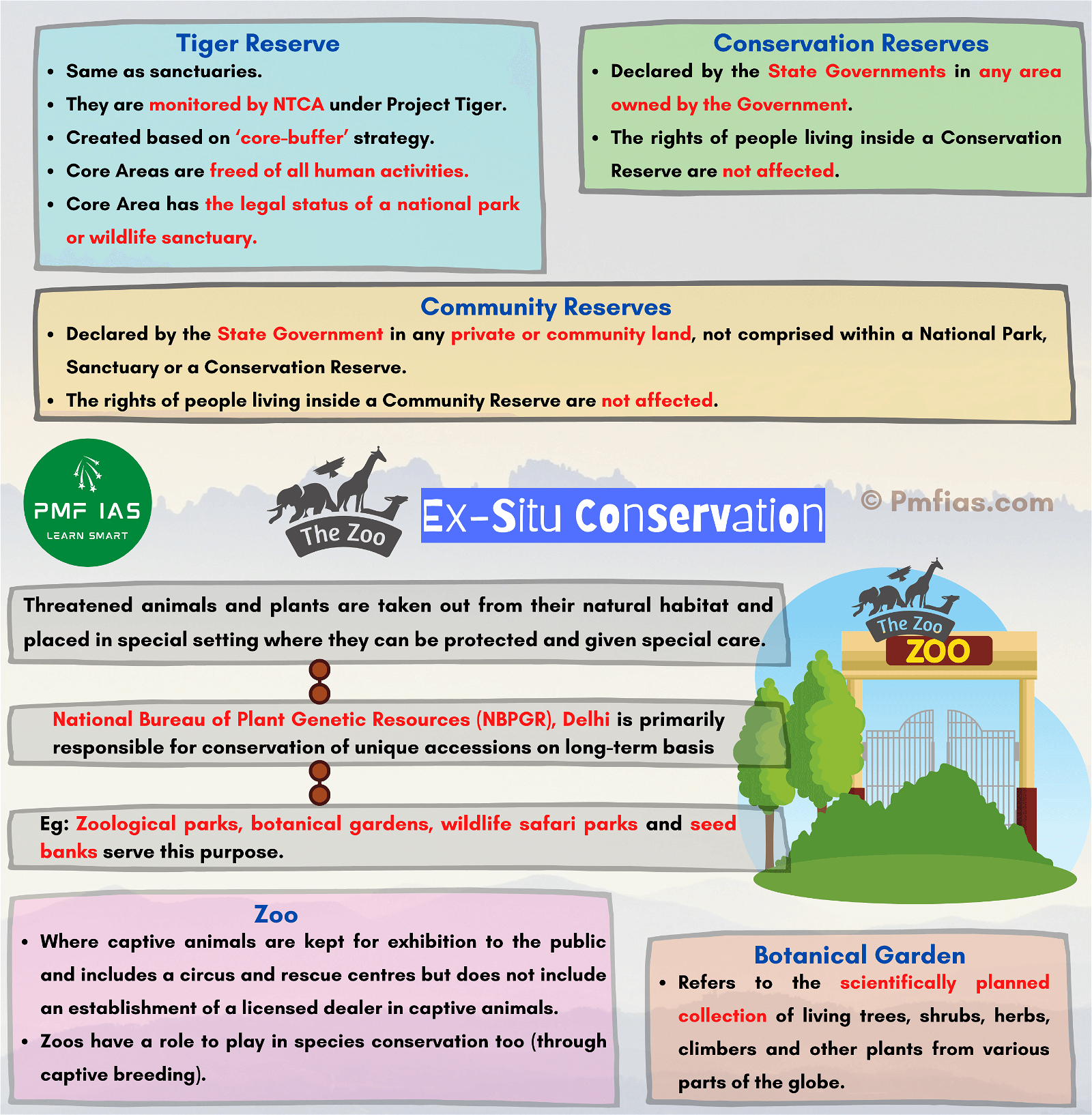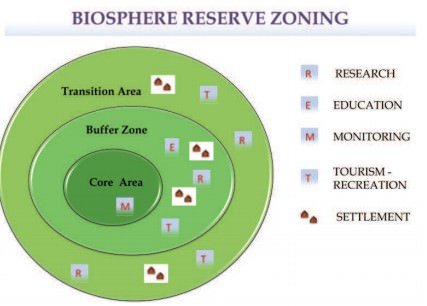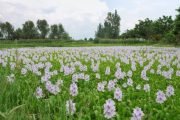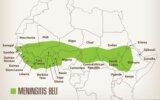
Biodiversity Conservation: In Situ & Ex Situ Conservation
Subscribe to Never Miss an Important Update! Assured Discounts on New Products!
Must Join PMF IAS Telegram Channel & PMF IAS History Telegram Channel
Last updated on April 19, 2024 9:30 PM
Biodiversity Conservation
- When we conserve and protect the whole ecosystem, its biodiversity at all levels is protected. E.g. we save the entire forest to save the tiger. This approach is called in in-situ (on site) conservation.
- However, when there are situations where an animal or plant is endangered or threatened and needs urgent measures to save it from extinction, ex-situ (off-site) conservation is the desirable approach.
Benefits of Biodiversity conservation
- Conservation of biological diversity leads to conservation of essential ecological diversity to preserve the continuity of food chains.
- The genetic diversity of plants and animals is preserved.
- It ensures the sustainable utilisation of life support systems on earth.
- It provides a vast knowledge of potential use to the community.
- A reservoir of wild animals and plants is preserved, thus enabling them to be introduced, if need be, in the surrounding areas.
- Biodiversity conservation assures sustainable utilization of potential resources.


In situ conservation
- In-situ conservation is the on-site conservation of genetic resources in natural populations of plant or animal species.
- In India, ecologically unique and biodiversity-rich regions are legally protected as biosphere reserves, national parks, sanctuaries, reserved forests, protected forests and nature reserves.
- India now has 18 biosphere reserves, 104 national parks and 500 wildlife sanctuaries.
- Plantation, cultivation, grazing, felling trees, hunting and poaching are prohibited in biosphere reserves, national parks and sanctuaries.
Protected Area Network in India
- National Board for Wildlife (NBWL), chaired by the Prime Minister of India provides for policy framework for wildlife conservation in the country.
- The National Wildlife Action Plan (2002-2016) was adopted in 2002, emphasizing the people’s participation and their support for wildlife conservation.
Reserved & Protected Forests
- As of present, reserved forests and protected forests differ in one important way:
- Rights to all activities like hunting, grazing, etc. in reserved forests are banned unless specific orders are issued otherwise.
- In protected areas, rights to activities like hunting and grazing are sometimes given to communities living on the fringes of the forest, who sustain their livelihood from forest resources or products.
- The first reserve forest in India was Satpura National Park in Madhya Pradesh.
- Typically, reserved forests are often upgraded to the status of wildlife sanctuaries, which in turn may be upgraded to the status of national parks, with each category receiving a higher degree of protection and government funding.
In terms of protection, National Parks > Wildlife Sanctuary > Reserved forests > Protected forests
Wildlife Sanctuaries or wildlife refuges
- Wildlife Sanctuaries or wildlife refuges are home to various endangered species.
- They are safe from hunting, predation or competition.
- They are safeguarded from extinction in their natural habitat.
- Certain rights of people living inside the Sanctuary could be permitted.
- Grazing, firewood collection by tribals is allowed but strictly regulated.
- Settlements not allowed (few exceptions: tribal settlements do exist constant; efforts are made to relocate them).
- A Sanctuary can be promoted to a National Park.
- There are more than 500 wildlife sanctuaries in India.
National Park
- National parks are areas reserved for wildlife where they can freely use the habitats and natural resources.
- The difference between a Sanctuary and a National Park mainly lies in the vesting of rights of people living inside.
- Unlike a Sanctuary, where certain rights can be allowed, in a National Park, no rights are allowed.
- No grazing of any livestock shall also be permitted inside a National Park while in a Sanctuary, the Chief Wildlife Warden may regulate, control or prohibit it.
Eco-Sensitive Zones
- The National Wildlife Action Plan (2002–2016) of MoEFCC stipulated that state governments should declare land falling within 10 km of the boundaries of national parks and wildlife sanctuaries as eco-fragile zones or ESZs under the Environmental (Protection) Act, 1986.
- The purpose of the ESZ was to provide more protection to the parks by acting as a shock absorber or transition zone.
- Eco-Sensitive Zones would minimise forest depletion and man-animal conflict.
- The protected areas are based on the core and buffer model of management.
- The core area has the legal status of being a national park.
- The buffer area, however, does not have legal status of being a national park and could be a reserved forest, wildlife sanctuary or tiger reserve.
Q. With reference to ‘Eco-Sensitive Zones’, which of the following statements is/are correct?
- Eco-Sensitive Zones are the areas that are declared under the Wildlife (Protection) Act, 1972.
- The purpose of the declaration of Eco-Sensitive Zones is to prohibit all kinds of human activities, in those zones except agriculture.
Select the correct answer using the code given below.
- 1 only
- 2 only
- Both 1 and 2
- Neither 1 nor 2
- Answer: d) Neither
Biosphere Reserve
- Large areas of protected land for conservation of wildlife, plant and animal resources and traditional life of the tribals living in the area.
- May have one or more national parks or wildlife sanctuaries in it.
Core area
- Comprises a strictly protected ecosystem for conserving ecosystems, species and genetic variation.
- In core or natural zone human activity is not allowed.
Buffer zone
- Used for scientific research, monitoring, training and education.
Transition area
- Ecologically sustainable human settlements and economic activities (tourism) are permitted.
- With the cooperation of reserve management and local people, several human activities like settlements, cropping, recreation, and forestry are carried out without disturbing the environment.

Biosphere Reserves in India
| Name | State | Type | Key fauna |
| 1. Nilgiri Biosphere Reserve | Tamil Nadu, Kerala and Karnataka | Western Ghats | Nilgiri tahr, lion-tailed macaque |
| 2. Nanda Devi National Park & Biosphere Reserve | Uttarakhand | Western Himalayas | Snow Leopard, Himalayan Black Bear |
| 3. Gulf of Mannar | Tamil Nadu | Coasts | Dugong or sea cow |
| 4. Nokrek | Meghalaya (Part of Garo Hills) | East Himalayas | Red panda |
| 5. Sundarbans | West Bengal | Gangetic Delta | Royal Bengal tiger |
| 6. Manas | Assam (Terai region) | East Himalayas | Golden langur, red panda |
| 7. Simlipal | Odisha | Deccan Peninsula | Gaur, royal Bengal tiger, elephant |
| 8. Dihang-Dibang | Arunachal Pradesh | Eastern Himalaya | |
| 9. Pachmarhi Biosphere Reserve | Madhya Pradesh | Semi-Arid | Giant squirrel, flying squirrel |
| 10. Achanakmar-Amarkantak Biosphere Reserve | Madhya Pradesh, Chhattisgarh | Maikala Hills | Four-horned antelope, Indian wild dog, Sarus crane, White-rumped vulture |
| 11. Great Rann of Kutch | Gujarat | Desert | Indian wild ass |
| 12. Cold Desert | Himachal Pradesh | Western Himalayas | Snow leopard |
| 13. Khangchendzonga | Sikkim | East Himalayas | Snow leopard, red panda |
| 14. Agasthyamalai Biosphere Reserve | Kerala, Tamil Nadu | Western Ghats | Nilgiri Tahr, elephants |
| 15. Great Nicobar Biosphere Reserve | Andaman and Nicobar Islands | Islands | Saltwater crocodile |
| 16. Dibru-Saikhowa | Assam | East Himalayas | Golden langur |
| 17. Seshachalam Hills | Andhra Pradesh | Eastern Ghats | |
| 18. Panna | Madhya Pradesh | Catchment Area of the Ken River | Tiger, chital, chinkara, sambhar and sloth bear |
Q. The most important strategy for the conservation of biodiversity together with traditional human life is the establishment of
- biosphere reserves
- botanical gardens
- national parks
- wildlife sanctuaries
Answer: a)
Tiger Reserves
- Same as sanctuaries. But they are monitored by NTCA under Project Tiger.
- The various tiger reserves were created in the country based on ‘core-buffer’ strategy.
Core area
- The core areas are freed of all human activities.
- It has the legal status of a national park or wildlife sanctuary.
- Collection of minor forest produce, grazing, and other human disturbances are not allowed.
Buffer areas
- Twin objectives:
- providing habitat supplement to spill overpopulation of wild animals from core area.
- provide site-specific co-developmental inputs to surrounding villages for relieving their impact on core area.
- Collection of minor forest produce and grazing by tribals is allowed on a sustainable basis.
- The Forest Rights Act passed by the Indian government in 2006 recognises the rights of some forest dwelling communities in forest areas.
Conservation Reserves
- Conservation Reserves can be declared by the State Governments in any area owned by the Government, particularly the areas adjacent to National Parks and Sanctuaries and those areas which link one Protected Area with another.
- Such a declaration should be made after having consultations with the local communities.
- The rights of people living inside a Conservation Reserve are not affected.
Community Reserves
- Community Reserves can be declared by the State Government in any private or community land, not comprised within a National Park, Sanctuary or a Conservation Reserve, where an individual or a community has volunteered to conserve wildlife and its habitat.
- As in the case of a Conservation Reserve, the rights of people living inside a Community Reserve are not affected.
Sacred Groves
- India has a history of religious/cultural traditions that emphasised the protection of nature.
- In many cultures, tracts of forest were set aside, and all the trees and wildlife within were venerated and given total protection.
- Such sacred groves are found in Khasi and Jaintia Hills in Meghalaya, Aravalli Hills of Rajasthan, Western Ghat regions of Karnataka and Maharashtra and the Sarguja, Chanda and Bastar areas of Madhya Pradesh.
- In Meghalaya, the sacred groves are the last refuges for a large number of rare and threatened plants.
Ex Situ Conservation
- In this approach, threatened animals and plants are taken out from their natural habitat and placed in special setting where they can be protected and given special care.
- Zoological parks, botanical gardens, wildlife safari parks and seed banks serve this purpose.
- There are many animals that have become extinct in the wild but continue to be maintained in zoological parks.
- In recent years ex-situ conservation has advanced beyond keeping threatened species.
- Now gametes of threatened species can be preserved in viable and fertile condition for long periods using cryopreservation techniques.
- Eggs can be fertilized in vitro, and plants can be propagated using tissue culture methods.
- Seeds of different genetic strains of commercially important plants can be kept for long periods in seed banks.
- The national gene bank at National Bureau of Plant Genetic Resources (NBPGR), Delhi is primarily responsible for conservation of unique accessions on long-term basis, as base collections for posterity, predominantly in the form of seeds.
Botanical garden
- Botanical garden refers to the scientifically planned collection of living trees, shrubs, herbs, climbers and other plants from various parts of the globe.
Purpose of botanical gardens
- To study the taxonomy as well as growth of plants.
- To study the introduction and acclimatization process of exotic plants.
- It augments conserving rare and threatened species.
Zoo
- Zoo is an establishment, whether stationary or mobile, where captive animals are kept for exhibition to the public and includes a circus and rescue centres but does not include an establishment of a licensed dealer in captive animals.
- The initial purpose of zoos was entertainment, over the decades, zoos have got transformed into centres for wildlife conservation and environmental education.
- Apart from saving individual animals, zoos have a role to play in species conservation too (through captive breeding).
- Zoos provide an opportunity to open up a whole new world, and this could be used in sensitizing visitors regarding the value and need for conservation of wildlife.
Which one of the following is not a site for in-situ method of conservation of flora?
- Biosphere Reserves
- Botanical Garden
- National Park
- Wildlife Sanctuary
- Botanical Garden: Plants are bred in a protected environment far from their natural home, especially for research purposes. So, its ex-situ conservation.
- Rest all along with protected forests and reserved forests are in-situ conservation methods.
Answer: b) Botanical Garden
Historic Citizen Movements to Conserve Biodiversity
Chipko Movement
- It is a social-ecological movement that practiced the Gandhian methods of satyagraha and nonviolent resistance, through the act of hugging trees to protect them from falling.
- The modern Chipko movement started in the early 1970s in the Garhwal Himalayas of Uttarakhand, with growing awareness towards rapid deforestation.
- The landmark event in this struggle took place on March 26, 1974, when a group of peasant women in Reni village, Hemwalghati, in Chamoli district, Uttarakhand, India, acted to prevent the cutting of trees and reclaim their traditional forest rights that were threatened by the contractor system of the state Forest Department.
- Their actions inspired hundreds of such actions at the grassroots level throughout the region.
- By the 1980s the movement had spread throughout India and led to formulation of people-sensitive forest policies, which put a stop to the open felling of trees in regions as far reaching as Vindhyas and the Western Ghats.
- The first recorded event of Chipko however, took place in village Khejarli, Jodhpur district, in 1730 AD, when 363 Bishnois, led by Amrita Devi sacrificed their lives while protecting green Khejri trees, considered sacred by the community, by hugging them.
Appiko Movement
- Appiko movement was a revolutionary movement based on environmental conservation in India.
- The Chipko movement in Uttarakhand in the Himalayas inspired the villagers of the district of Karnataka province in southern India to launch a similar movement to save their forests.
- In September 1983, men, women and children of Salkani ‘hugged the trees’ in Kalase forest. (The local term for ‘hugging’ in Kannada is appiko.)
- Appiko movement gave birth to a new awareness all over southern India.
Last updated on April 19, 2024 9:30 PM


















best article thanks for the information